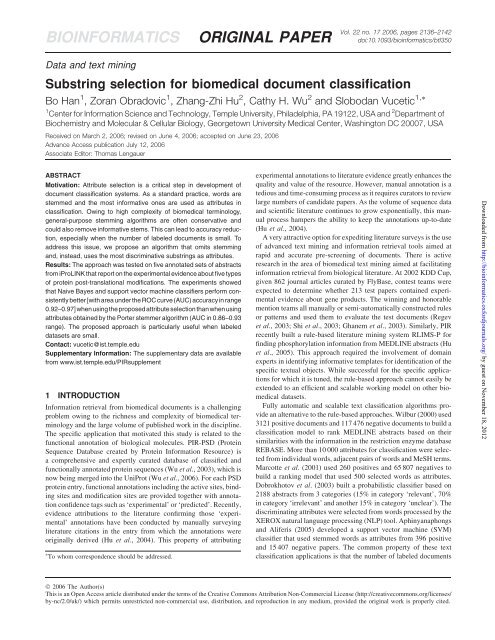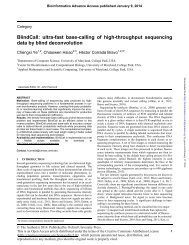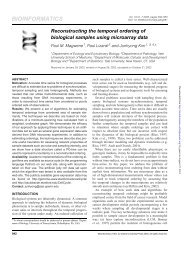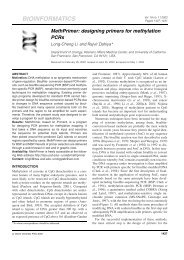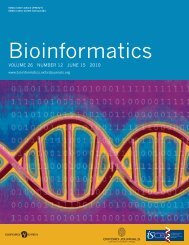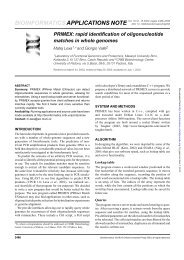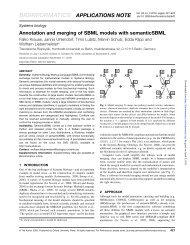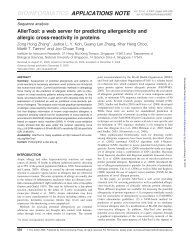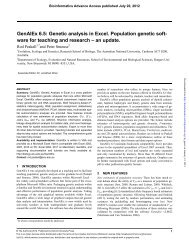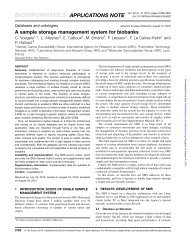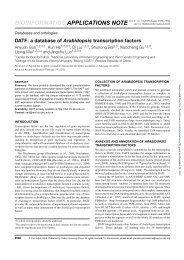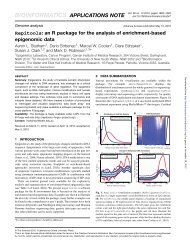Substring selection for biomedical document classification
Substring selection for biomedical document classification
Substring selection for biomedical document classification
Create successful ePaper yourself
Turn your PDF publications into a flip-book with our unique Google optimized e-Paper software.
BIOINFORMATICS ORIGINAL PAPER<br />
Data and text mining<br />
Vol. 22 no. 17 2006, pages 2136–2142<br />
doi:10.1093/bioin<strong>for</strong>matics/btl350<br />
<strong>Substring</strong> <strong>selection</strong> <strong>for</strong> <strong>biomedical</strong> <strong>document</strong> <strong>classification</strong><br />
Bo Han 1 , Zoran Obradovic 1 , Zhang-Zhi Hu 2 , Cathy H. Wu 2 and Slobodan Vucetic 1,<br />
1 Center <strong>for</strong> In<strong>for</strong>mation Science and Technology, Temple University, Philadelphia, PA 19122, USA and 2 Department of<br />
Biochemistry and Molecular & Cellular Biology, Georgetown University Medical Center, Washington DC 20007, USA<br />
Received on March 2, 2006; revised on June 4, 2006; accepted on June 23, 2006<br />
Advance Access publication July 12, 2006<br />
Associate Editor: Thomas Lengauer<br />
ABSTRACT<br />
Motivation: Attribute <strong>selection</strong> is a critical step in development of<br />
<strong>document</strong> <strong>classification</strong> systems. As a standard practice, words are<br />
stemmed and the most in<strong>for</strong>mative ones are used as attributes in<br />
<strong>classification</strong>. Owing to high complexity of <strong>biomedical</strong> terminology,<br />
general-purpose stemming algorithms are often conservative and<br />
could also remove in<strong>for</strong>mative stems. This can lead to accuracy reduction,<br />
especially when the number of labeled <strong>document</strong>s is small. To<br />
address this issue, we propose an algorithm that omits stemming<br />
and, instead, uses the most discriminative substrings as attributes.<br />
Results: The approach was tested on five annotated sets of abstracts<br />
from iProLINK that report on the experimental evidence about five types<br />
of protein post-translational modifications. The experiments showed<br />
that Naive Bayes and support vector machine classifiers per<strong>for</strong>m consistently<br />
better [with area under the ROC curve (AUC) accuracy in range<br />
0.92–0.97] when using the proposed attribute <strong>selection</strong> than when using<br />
attributes obtained by the Porter stemmer algorithm (AUC in 0.86–0.93<br />
range). The proposed approach is particularly useful when labeled<br />
datasets are small.<br />
Contact: vucetic@ist.temple.edu<br />
Supplementary In<strong>for</strong>mation: The supplementary data are available<br />
from www.ist.temple.edu/PIRsupplement<br />
1 INTRODUCTION<br />
In<strong>for</strong>mation retrieval from <strong>biomedical</strong> <strong>document</strong>s is a challenging<br />
problem owing to the richness and complexity of <strong>biomedical</strong> terminology<br />
and the large volume of published work in the discipline.<br />
The specific application that motivated this study is related to the<br />
functional annotation of biological molecules. PIR-PSD (Protein<br />
Sequence Database created by Protein In<strong>for</strong>mation Resource) is<br />
a comprehensive and expertly curated database of classified and<br />
functionally annotated protein sequences (Wu et al., 2003), which is<br />
now being merged into the UniProt (Wu et al., 2006). For each PSD<br />
protein entry, functional annotations including the active sites, binding<br />
sites and modification sites are provided together with annotation<br />
confidence tags such as ‘experimental’ or ‘predicted’. Recently,<br />
evidence attributions to the literature confirming those ‘experimental’<br />
annotations have been conducted by manually surveying<br />
literature citations in the entry from which the annotations were<br />
originally derived (Hu et al., 2004). This property of attributing<br />
To whom correspondence should be addressed.<br />
experimental annotations to literature evidence greatly enhances the<br />
quality and value of the resource. However, manual annotation is a<br />
tedious and time-consuming process as it requires curators to review<br />
large numbers of candidate papers. As the volume of sequence data<br />
and scientific literature continues to grow exponentially, this manual<br />
process hampers the ability to keep the annotations up-to-date<br />
(Hu et al., 2004).<br />
A very attractive option <strong>for</strong> expediting literature surveys is the use<br />
of advanced text mining and in<strong>for</strong>mation retrieval tools aimed at<br />
rapid and accurate pre-screening of <strong>document</strong>s. There is active<br />
research in the area of <strong>biomedical</strong> text mining aimed at facilitating<br />
in<strong>for</strong>mation retrieval from biological literature. At 2002 KDD Cup,<br />
given 862 journal articles curated by FlyBase, contest teams were<br />
expected to determine whether 213 test papers contained experimental<br />
evidence about gene products. The winning and honorable<br />
mention teams all manually or semi-automatically constructed rules<br />
or patterns and used them to evaluate the test <strong>document</strong>s (Regev<br />
et al., 2003; Shi et al., 2003; Ghanem et al., 2003). Similarly, PIR<br />
recently built a rule-based literature mining system RLIMS-P <strong>for</strong><br />
finding phosphorylation in<strong>for</strong>mation from MEDLINE abstracts (Hu<br />
et al., 2005). This approach required the involvement of domain<br />
experts in identifying in<strong>for</strong>mative templates <strong>for</strong> identification of the<br />
specific textual objects. While successful <strong>for</strong> the specific applications<br />
<strong>for</strong> which it is tuned, the rule-based approach cannot easily be<br />
extended to an efficient and scalable working model on other <strong>biomedical</strong><br />
datasets.<br />
Fully automatic and scalable text <strong>classification</strong> algorithms provide<br />
an alternative to the rule-based approaches. Wilbur (2000) used<br />
3121 positive <strong>document</strong>s and 117 476 negative <strong>document</strong>s to build a<br />
<strong>classification</strong> model to rank MEDLINE abstracts based on their<br />
similarities with the in<strong>for</strong>mation in the restriction enzyme database<br />
REBASE. More than 10 000 attributes <strong>for</strong> <strong>classification</strong> were selected<br />
from individual words, adjacent pairs of words and MeSH terms.<br />
Marcotte et al. (2001) used 260 positives and 65 807 negatives to<br />
build a ranking model that used 500 selected words as attributes.<br />
Dobrokhotov et al. (2003) built a probabilistic classifier based on<br />
2188 abstracts from 3 categories (15% in category ‘relevant’, 70%<br />
in category ‘irrelevant’ and another 15% in category ‘unclear’). The<br />
discriminating attributes were selected from words processed by the<br />
XEROX natural language processing (NLP) tool. Aphinyanaphongs<br />
and Aliferis (2005) developed a support vector machine (SVM)<br />
classifier that used stemmed words as attributes from 396 positive<br />
and 15 407 negative papers. The common property of these text<br />
<strong>classification</strong> applications is that the number of labeled <strong>document</strong>s<br />
Ó 2006 The Author(s)<br />
This is an Open Access article distributed under the terms of the Creative Commons Attribution Non-Commercial License (http://creativecommons.org/licenses/<br />
by-nc/2.0/uk/) which permits unrestricted non-commercial use, distribution, and reproduction in any medium, provided the original work is properly cited.<br />
Downloaded from<br />
http://bioin<strong>for</strong>matics.ox<strong>for</strong>djournals.org/ by guest on November 18, 2012
was moderate to high, and that the extracted attributes were based<br />
on word occurrences. Most often, the <strong>document</strong>s were preprocessed<br />
by word stemming in order to reduce the number of unique words<br />
without significant loss of in<strong>for</strong>mation.<br />
When labeled datasets are small (i.e. containing up to a few<br />
hundred labeled <strong>document</strong>s), general-purpose stemming algorithms<br />
can result in a dictionary that contains many infrequently occurring<br />
but in<strong>for</strong>mative words. Subsequent attribute <strong>selection</strong> would tend to<br />
remove those infrequent in<strong>for</strong>mative words and the resulting classifier<br />
would have reduced accuracy. The vast and complex <strong>biomedical</strong><br />
terminology only exacerbates this problem. Specifically,<br />
semantically related <strong>biomedical</strong> terms that share the same stem or<br />
morpheme are often not reducible to the same stem using popular<br />
stemming algorithms. As an example, ‘phosphorylated’, ‘phosphate’,<br />
‘phosphorylatable’, ‘phosphorylase’, ‘phosphopeptides’<br />
all contain the same stem ‘phosph’, which can be highly useful<br />
<strong>for</strong> identification of <strong>document</strong>s related to protein phosphorylation.<br />
However, Porter stemmer (Porter, 1980), one of the most popular<br />
stemming algorithms, can only reduce words from the example to<br />
‘phosphoryl’, ‘phosphat’, ‘phosphorylat’, ‘phosphorylas’, ‘phosphopeptid’,<br />
respectively. As a result, five attributes would be constructed<br />
to represent occurrences of these words. If the labeled dataset is<br />
small, it is likely that none of these attributes are selected <strong>for</strong> <strong>classification</strong><br />
owing to their infrequent occurrence.<br />
In addition to the difficulties stemming algorithms have in producing<br />
maximally in<strong>for</strong>mative stems, their inherent drawback is the<br />
removal of suffixes based on general grammar rules. Biomedical<br />
terms often contain in<strong>for</strong>mative suffixes. For example, ‘ase’ is a<br />
suffix common to proteins that function as enzymes (e.g. kinase)<br />
and its occurrence is necessary in the identification of <strong>document</strong>s<br />
that are related to such enzymes. This in<strong>for</strong>mation is not recoverable<br />
if popular stemming algorithms are used. The drawbacks of stemming<br />
algorithms have been observed by other researchers. Nenadic<br />
et al. (2003) studied the per<strong>for</strong>mance of a text <strong>classification</strong><br />
approach by comparing different types of attribute extraction procedures.<br />
Their results show that the use of standard stemming<br />
algorithms as a preprocessing step does not improve accuracy of<br />
<strong>biomedical</strong> text <strong>classification</strong>.<br />
It is evident that new and unique methods need to be developed <strong>for</strong><br />
the extraction of in<strong>for</strong>mative attributes from <strong>biomedical</strong> <strong>document</strong>s.<br />
Andrade et al. (1998) proposed a new stemming algorithm <strong>for</strong> <strong>biomedical</strong><br />
<strong>document</strong>s by applying a set of simple rules, such as two<br />
words with length larger than five have the same stem if they have<br />
the same prefix and their suffixes differ in at most two characters.<br />
Nenadic et al. (2003) and Rice et al. (2005) applied an enhanced<br />
version of the C-value method to extract domain-specific terms. The<br />
method needs rules of conflation to reduce term variants; it yields<br />
good per<strong>for</strong>mance only if sufficient training data are available.<br />
In this paper, we propose an effective and simple attribute <strong>selection</strong><br />
algorithm that derives attributes from substrings. The algorithm<br />
explores all substrings in labeled <strong>document</strong>s and selects the ones<br />
that most successfully discriminate between positive and negative<br />
<strong>document</strong>s. Attributes are derived as counts of the most in<strong>for</strong>mative<br />
non-redundant substrings. A <strong>classification</strong> model (i.e. the Naive<br />
Bayes classifier) is constructed from the labeled dataset using the<br />
selected attributes. The appeal of this procedure is that attribute<br />
<strong>selection</strong> is driven directly by the labeled dataset. In addition,<br />
substring-based attribute extraction provides increased flexibility<br />
in comparison with the traditional word-based procedures.<br />
<strong>Substring</strong> <strong>selection</strong> <strong>for</strong> <strong>biomedical</strong> <strong>document</strong> <strong>classification</strong><br />
iProLINK (Hu et al., 2004) is a new PIR resource that provides<br />
multiple annotated literature corpora to facilitate text mining<br />
research in the areas of literature-based database curation, named<br />
entity recognition, and protein ontology development. We evaluated<br />
the approach on five iProLINK datasets of tagged abstracts corresponding<br />
to post-translational protein modifications (PTMs), i.e.<br />
acetylation, glycosylation, methylation, phosphorylation and<br />
hydroxylation. The presented experimental evidence suggests<br />
that classifiers that use the proposed attribute extraction algorithm<br />
per<strong>for</strong>m better than the ones that use attributes obtained by the<br />
standard Porter stemmer algorithm.<br />
2 METHODS<br />
The proposed substring <strong>selection</strong> algorithm is based on enumerating the<br />
usefulness of each frequently occurring substring and selecting the most<br />
in<strong>for</strong>mative subset of substrings as attributes <strong>for</strong> text <strong>classification</strong>.<br />
2.1 Attribute extraction<br />
Given a corpus of N <strong>document</strong>s {di , i ¼ 1, ..., N}, each <strong>document</strong> di is<br />
parsed into a set of words wij, i ¼ 1, ..., N , j ¼ 1, ..., Ki, that are separated<br />
by spacer symbols. Ki is number of words in <strong>document</strong> di. We considered two<br />
approaches <strong>for</strong> attribute extraction: (1) Word-Based, which is the standard<br />
approach based on Porter stemming and (2) <strong>Substring</strong>-Based, which is the<br />
proposed approach.<br />
Porter stemming is a highly effective, simple algorithm that removes word<br />
suffixes in order to reduce related words (e.g. connected, connection) to the<br />
same stem (e.g. connect). The Word-Based algorithm begins with the construction<br />
of a dictionary of unique stemmed words from the corpus. Each<br />
<strong>document</strong> di is then represented as a vector fi ¼ [fi1, ..., fiK], where fik is the<br />
count of stem sk in di, and K is the dictionary size. The Porter stemmer is<br />
appropriate <strong>for</strong> general-subject English <strong>document</strong>s because it manages to<br />
significantly reduce the dictionary size without the excessive conflation of<br />
unrelated words. Owing to complex terminology and unconventional naming,<br />
standard grammar-based stemmers (e.g. Porter stemming) can be too<br />
conservative and result in a variety of closely related but rarely occurring<br />
terms. In addition, it can result in the removal of potentially useful suffixes.<br />
In order to avoid the pitfalls of grammar-based stemming and to achieve a<br />
highly flexible attribute extraction, the <strong>Substring</strong>-Based approach is proposed.<br />
It constructs a dictionary of unique substrings which occur in the<br />
<strong>document</strong> corpus. A substring is defined as a consecutive list of symbols<br />
within a word. As in the Word-Based approach, given a dictionary, each<br />
<strong>document</strong> di is represented as vector fi ¼ [fi1, ..., fiK], where fik is the count of<br />
substring sk in di, and K is the dictionary size.<br />
Efficient procedures <strong>for</strong> construction of word or substring dictionary are<br />
available. For example, suffix trees can be used where each node represents a<br />
unique substring s, i.e. a suffix of its parent node. The suffix tree construction<br />
takes time linear to a number of words in the corpus. A node representing<br />
substring sk is assigned a frequency vector fk ¼ [f1k, ..., fNk], where fik is the<br />
count of substring sk in <strong>document</strong> di and N is number of <strong>document</strong>s in the<br />
corpus.<br />
Since each word w contributes j w j ( j w j +1)/2 substrings, it is evident<br />
that the <strong>Substring</strong>-Based dictionary is larger than the Word-Based dictionary.<br />
For example, <strong>for</strong> the five datasets (see Section 3.1) used in the experiments<br />
the total number of substrings is on average 39 times larger than the<br />
number of words and the <strong>Substring</strong>-Based dictionary size is on average about<br />
15 times larger than the Word-Based dictionary size. Additionally, to find<br />
word w in a dictionary requires j w j comparisons, while to find all of its<br />
substrings takes j w j ( j w j +1)/2 comparisons. For example, since the average<br />
word length in the five datasets from Section 3.1 is 7.2 and 6.2 be<strong>for</strong>e and<br />
after Porter stemming, the <strong>Substring</strong>-Based approach is 4 times slower<br />
than the Word-Based approach. However, since the <strong>Substring</strong>-Based<br />
approach is aimed towards problems with small sets of labeled <strong>document</strong>s,<br />
2137<br />
Downloaded from<br />
http://bioin<strong>for</strong>matics.ox<strong>for</strong>djournals.org/ by guest on November 18, 2012
B.Han et al.<br />
the added computational complexity should not be considered as a serious<br />
drawback.<br />
2.2 Attribute <strong>selection</strong><br />
By observing that rare substrings could not be used successfully to improve<br />
<strong>classification</strong> per<strong>for</strong>mance, all substrings that occur in less than three <strong>document</strong>s<br />
are excluded from further consideration. In the following step, the<br />
relevance of each frequent substring is evaluated. In principle, any of the<br />
numerous feature <strong>selection</strong> algorithms from machine learning could be<br />
suitable <strong>for</strong> this step.<br />
In<strong>for</strong>mation gain (IG) was used as the benchmark because it is considered<br />
very appropriate <strong>for</strong> text <strong>classification</strong> (Yang and Pederson, 1997). Given a<br />
multi-valued attribute X 2 {x1, ..., xK} and class variable Y 2 {1, ..., C}, the<br />
IG of attribute X is calculated as<br />
IGðXÞ ¼ XK<br />
i¼1<br />
X C<br />
j¼1<br />
pðX ¼ xi‚Y ¼ jÞ<br />
pðX ¼ xi‚Y ¼ jÞ · log2 pðX ¼ xiÞ · pðY ¼ jÞ :<br />
The attributes with high IG value are considered relevant.<br />
The IG criterion is biased towards frequently occurring attributes. To<br />
address this drawback, we used the Wilcoxon rank-sum test (WRST) to<br />
measure substring relevance. The relevance of substring s k is obtained by<br />
sorting the <strong>document</strong>s by their attribute values, assigning them ranks and<br />
summing up the ranks of the positive and negative <strong>document</strong>s. If the attribute<br />
is not relevant, the average ranks of positive and negative <strong>document</strong>s should<br />
be similar. Using the Gaussian approximation, the P-value of the test is<br />
computed using complementary error function (Cody, 1969) erfc( j Z j ),<br />
where Z ¼ (U E(U))/sqrt(Var(U)), U is sum of ranks of positive samples,<br />
and E(U) and Var(U) are the mean and the variance of U. A small p-value<br />
indicates high attribute relevance.<br />
2.3 Removing redundant attributes<br />
Attributes obtained by the substring-based approach and selected by either<br />
IG or WRST are likely to have high degree of redundancy. The redundancy<br />
should be reduced because it can have an adverse effect on learning. Possible<br />
redundancy-reduction procedures include latent semantic analysis (Berry<br />
et al., 1995) or heuristics that ensure that no two substrings in the selected<br />
set are prefix, suffix or subset of each other. Based on our pilot study, we<br />
decided to apply a rather simple but effective approach that uses a correlation<br />
measure. Given a threshold T, the approach ensures that no two attributes<br />
have a correlation coefficient that exceeds T. The procedure compares each<br />
pair of substring attributes, and if their correlation is above T, an attribute<br />
with smaller relevance is removed.<br />
2.4 Ranking algorithms<br />
For <strong>document</strong> ranking, we considered SVMs and Naive Bayes classifiers.<br />
These <strong>classification</strong> algorithms are directly applicable to ranking because<br />
their outputs are correlated with the posterior probability of a positive <strong>document</strong>.<br />
SVMs (Vapnik, 1995) are optimized to find the decision hyperplane<br />
with the maximum separation margin between positive and negative data<br />
points. By representing <strong>document</strong> di with pair (fi,yi), where fi ¼ [f1i ..., fKi]is<br />
attribute vector, fki is count of substring sk in <strong>document</strong> di, yi ¼ 1 <strong>for</strong><br />
negative <strong>document</strong>s and yi ¼ +1 <strong>for</strong> positive <strong>document</strong>s, the output of SVM<br />
<strong>for</strong> a <strong>document</strong> with attribute vector f ¼ [f1, ..., fK] is calculated as<br />
SVMðf Þ¼b þ XNS<br />
aiyiKðf i‚f Þ‚<br />
where N S is number of support vectors selected from training data, a i, i ¼<br />
1, ..., NS, and b are model parameters obtained by optimization, and K is an<br />
appropriate kernel function. The reported experimental evidence suggests<br />
that SVMs are very successful in the <strong>classification</strong> of high-dimensional data,<br />
and that SVMs with linear kernels are often as accurate as SVM with nonlinear<br />
kernels in text <strong>classification</strong> (Joachims, 1998).<br />
2138<br />
i¼1<br />
Naive Bayes is a simple classifier that operates under the assumption that<br />
attributes are conditionally independent given a class variable. In this study<br />
we considered a multinomial Naive Bayes classifier, known to be appropriate<br />
<strong>for</strong> text <strong>classification</strong> (McCallum and Nigam, 1998). For binary <strong>classification</strong>,<br />
the output of multinomial Naive Bayes classifier <strong>for</strong> a <strong>document</strong> with<br />
the attribute vector f ¼ [f 1, ..., f K] can be expressed as<br />
Pðy¼ þ1j f Þ Pþ XK<br />
NBðf Þ¼ log ¼ log þ f k · log<br />
Pðy¼ 1 j f Þ P k¼1<br />
P+ k<br />
Pk where P + and P are fractions of positive and negative training <strong>document</strong>s,<br />
and P þ k and P k are frequencies of substring sk in positive and negative<br />
<strong>document</strong>s obtained as<br />
P + k ¼<br />
1 þ P<br />
K þ P K<br />
k¼1<br />
y i¼þ1 f ki<br />
P<br />
y i¼þ1 f ki<br />
‚P k ¼<br />
1 þ P<br />
K þ P K<br />
k¼1<br />
y i¼ 1 f ki<br />
P<br />
y i¼ 1 f ki<br />
The top ranked <strong>document</strong>s are the ones with highest SVM(f) or NB(f). It is<br />
worth noting that, <strong>for</strong> the purposes of <strong>document</strong>s ranking, the priors P + and<br />
P can be neglected. This is a highly useful property because the fractions of<br />
positive and negative training <strong>document</strong>s are unlikely to be related to their<br />
fractions found in unlabeled <strong>document</strong>s.<br />
2.5 Per<strong>for</strong>mance measures<br />
The main objective of <strong>document</strong> ranking is to achieve high ranking of<br />
positive <strong>document</strong>s. To evaluate ranking quality we used three measures<br />
that are based on ROC curves. An ROC curve measures the trade-off<br />
between true positive (TP; fraction of positives predicted as positives)<br />
and false positive (FP; fraction of negatives predicted as positives) prediction<br />
rates <strong>for</strong> different prediction cutoffs. Given the prediction cutoff , all <strong>document</strong>s<br />
with prediction [e.g. SVM(f), NB(f)] above are considered positive<br />
and all below negative. If is very small, no positives are predicted, and<br />
TP ¼ 0 and FP ¼ 0, while if is very large TP ¼ 1 and FP ¼ 1.<br />
Area under the ROC curve (AUC). Predictors that achieve high TP over<br />
a range of FP are considered accurate—AUC measures exactly this aspect of<br />
prediction quality. Perfect predictors achieve AUC ¼ 1, while predictors that<br />
provide random predictions have AUC ¼ 0.5.<br />
TOP10. It is calculated as the number of TP among the 10 highest<br />
ranked <strong>document</strong>s. This is a very relevant measure of ranking quality<br />
since high TOP10 accuracy is likely to motivate a user to continue using<br />
the system.<br />
FP80. It is calculated as FP rate when the predictor achieves 80% TP<br />
rate. This value is relevant <strong>for</strong> extensive uses of the ranking system where the<br />
goal is to retrieve majority of positive <strong>document</strong>s with minimal ef<strong>for</strong>t.<br />
3 RESULTS<br />
3.1 Datasets<br />
Five sets of <strong>document</strong>s summarized in Table 1 were used to evaluate<br />
the proposed procedure. They consisted of MEDLINE abstracts<br />
related to acetylation, glycosylation, methylation, phosphorylation<br />
and hydroxylation PTMs. Each abstract was labeled by PIR curators<br />
either as positive, if it reported experimental evidence about the<br />
PTM, or as negative, if it did not. The sizes of the datasets were<br />
moderate, ranging from 160 to 923, and were characterized by<br />
significant class imbalance, ranging from 5:1 to 17:1. To further<br />
evaluate the <strong>classification</strong> per<strong>for</strong>mance, we have used 1088<br />
untagged abstracts obtained from 347 PIR-PSD entries <strong>for</strong> proteins<br />
that contained glycosylation sites.<br />
All <strong>document</strong>s were preprocessed in the following way: upper<br />
case letters were mapped to lower case letters; all digits were<br />
mapped to digit symbol D; and all special symbols excluding<br />
:<br />
Downloaded from<br />
http://bioin<strong>for</strong>matics.ox<strong>for</strong>djournals.org/ by guest on November 18, 2012
Table 1. Summary of the five PTM datasets<br />
PTM types Positives Negatives<br />
Acetylation 55 868<br />
Glycosylation 41 711<br />
Hydroxylation 27 133<br />
Methylation 27 171<br />
Phosphorylation 79 389<br />
‘ ’ were mapped to spacer symbol B. A total of 524 common words<br />
(e.g. ‘and’, ‘of’, etc.) were removed from the <strong>document</strong>s.<br />
3.2 Experimental setup<br />
For each of the five datasets from Table 1, we per<strong>for</strong>med eight<br />
groups of experiments on each combination from (Word-Based,<br />
<strong>Substring</strong>-Based attribute extraction) · (SVM, Naive Bayes classifier)<br />
· (IG, WRST attribute <strong>selection</strong>). For each choice, we estimated<br />
AUC, TOP10 and FP80 accuracies using cross-validation. The<br />
procedure consisted of splitting the labeled <strong>document</strong>s randomly<br />
into K ¼ 5 equal subsets. One of the subsets was used <strong>for</strong> accuracy<br />
testing while the remaining ones were used <strong>for</strong> training. The process<br />
was repeated K ¼ 5 times, each time using a different subset <strong>for</strong><br />
testing. The whole 5-cross-validation procedure was repeated 20<br />
times, each time using different initial split of the labeled abstracts<br />
into K subsets. The average accuracy over the 100 experiments was<br />
reported as the accuracy estimate.<br />
While application of the Naive Bayes classifiers was straight<strong>for</strong>ward,<br />
use of SVMs required appropriate data preprocessing<br />
and parameter <strong>selection</strong>. For our experiments, we used Spider<br />
SVM software (http://www.kyb.tuebingen.mpg.de/bs/people/<br />
spider/) that runs SVMLight (Joachims, 1999) in the background.<br />
Be<strong>for</strong>e training, each attribute was scaled to range [0,1]. Since our<br />
datasets were highly imbalanced, we explored several values of<br />
the balanced_ridge parameter r, which modifies kernel matrices<br />
by balancing influence of positive and negative examples. It adds<br />
r·N + /(N + + N ) to positive examples at the diagonal of the kernel<br />
matrix and r·N /(N + + N ) to the negative examples, where N + is the<br />
number of positives, and N is the number of negatives. We<br />
explored a range of r values between 2 8 and 2 8 , and determined<br />
that r ¼ 10 4 works well on all five subsets. The default SVMLight<br />
value <strong>for</strong> the slack variable was used in all experiments.<br />
3.3 Accuracy comparison<br />
In Table 2 we show the comparison between eight different ranking<br />
algorithms. The first two (WB-NB-IG and WB-SVM-IG) used<br />
Word-Based (WB) attribute extraction and In<strong>for</strong>mation Gain<br />
(IG) attribute <strong>selection</strong>. SVM denotes SVMs and NB Naive<br />
Bayes ranking algorithm. The second two (WB-NB-WRST and<br />
WB-SVM-WRST) used Word-Based attribute extraction and<br />
Wilcoxon test (WRST) attribute <strong>selection</strong>. The third two (SB-<br />
NB-IG and SB-SVM-IG) used <strong>Substring</strong>-Based (SB) attribute<br />
extraction and In<strong>for</strong>mation Gain attribute <strong>selection</strong>. The final two<br />
(SB-NB-WRST and SB-SVM-WRST) used <strong>Substring</strong>-Based<br />
attribute extraction and Wilcoxon test attribute <strong>selection</strong>.<br />
For SB algorithms, our experiments revealed that the accuracy<br />
was the highest <strong>for</strong> the correlation threshold T ¼ 0.99, that it was<br />
<strong>Substring</strong> <strong>selection</strong> <strong>for</strong> <strong>biomedical</strong> <strong>document</strong> <strong>classification</strong><br />
Table 2. Accuracies of Word-based and <strong>Substring</strong>-based classifiers (WB,<br />
Word-Based; SB, <strong>Substring</strong>-Based; NB, Naive Bayes; SVM, support vector<br />
machines; IG, in<strong>for</strong>mation gain; WRST, Wilcoxon test)<br />
Method FP80 AUC TOP10<br />
(a)Acetylation group<br />
WB-NB-IG 0.237 ± 0.018 0.855 ± 0.005 3.00 ± 0.38<br />
WB-SVM-IG 0.200 ± 0.031 0.869 ± 0.035 3.20 ± 0.39<br />
WB-NB-WRST 0.236 ± 0.010 0.854 ± 0.013 3.02 ± 0.40<br />
WB-SVM-WRST 0.239 ± 0.028 0.851 ± 0.030 2.98 ± 0.31<br />
SB-NB-IG 0.229 ± 0.009 0.864 ± 0.007 3.08 ± 0.36<br />
SB-SVM-IG 0.168 ± 0.022 0.882 ± 0.014 4.16 ± 0.17<br />
SB-NB-WRST 0.146 ± 0.010 0.916 ± 0.007 4.64 ± 0.33<br />
SB-SVM-WRST 0.171 ± 0.024 0.893 ± 0.013 4.60 ± 0.30<br />
(b) Glycosylation group<br />
WB-NB-IG 0.152 ± 0.032 0.924 ± 0.006 5.20 ± 0.30<br />
WB-SVM-IG 0.176 ± 0.039 0.883 ± 0.009 4.56 ± 0.37<br />
WB-NB-WRST 0.121 ± 0.026 0.926 ± 0.005 5.36 ± 0.27<br />
WB-SVM-WRST 0.153 ± 0.038 0.890 ± 0.008 4.64 ± 0.29<br />
SB-NB-IG 0.052 ± 0.002 0.953 ± 0.004 5.80 ± 0.24<br />
SB-SVM-IG 0.118 ± 0.055 0.926 ± 0.022 5.40 ± 0.22<br />
SB-NB-WRST 0.035 ± 0.007 0.968 ± 0.004 6.28 ± 0.18<br />
SB-SVM-WRST 0.106 ± 0.076 0.929 ± 0.017 5.40 ± 0.37<br />
(c) Hydroxylation group<br />
WB-NB-IG 0.158 ± 0.041 0.888 ± 0.012 3.96 ± 0.36<br />
WB-SVM-IG 0.286 ± 0.095 0.803 ± 0.034 3.80 ± 0.54<br />
WB-NB-WRST 0.202 ± 0.032 0.858 ± 0.018 3.86 ± 0.32<br />
WB-SVM-WRST 0.325 ± 0.091 0.795 ± 0.039 3.78 ± 0.46<br />
SB-NB-IG 0.165 ± 0.015 0.911 ± 0.003 4.44 ± 0.14<br />
SB-SVM-IG 0.233 ± 0.031 0.870 ± 0.029 4.40 ± 0.20<br />
SB-NB-WRST 0.083 ± 0.010 0.948 ± 0.004 4.76 ± 0.09<br />
SB-SVM-WRST 0.173 ± 0.042 0.872 ± 0.025 4.50 ± 0.22<br />
(d) Methylation group<br />
WB-NB-IG 0.244 ± 0.040 0.866 ± 0.015 3.88 ± 0.23<br />
WB-SVM-IG 0.209 ± 0.026 0.854 ± 0.020 3.60 ± 0.36<br />
WB-NB-WRST 0.225 ± 0.028 0.880 ± 0.014 3.94 ± 0.26<br />
WB-SVM-WRST 0.202 ± 0.022 0.864 ± 0.015 3.78 ± 0.38<br />
SB-NB-IG 0.167 ± 0.038 0.916 ± 0.015 4.40 ± 0.19<br />
SB-SVM-IG 0.208 ± 0.040 0.863 ± 0.027 4.20 ± 0.32<br />
SB-NB-WRST 0.089 ± 0.010 0.940 ± 0.005 4.60 ± 0.25<br />
SB-SVM-WRST 0.196 ± 0.041 0.879 ± 0.029 4.40 ± 0.17<br />
(e) Phosphorylation group<br />
WB-NB-IG 0.220 ± 0.006 0.895 ± 0.008 6.16 ± 0.18<br />
WB-SVM-IG 0.103 ± 0.011 0.896 ± 0.008 6.20 ± 0.20<br />
WB-NB-WRST 0.215 ± 0.009 0.895 ± 0.011 6.20 ± 0.10<br />
WB-SVM-WRST 0.130 ± 0.012 0.898 ± 0.013 6.24 ± 0.22<br />
SB-NB-IG 0.096 ± 0.005 0.917 ± 0.003 6.48 ± 0.26<br />
SB-SVM-IG 0.152 ± 0.040 0.909 ± 0.016 6.56 ± 0.28<br />
SB-NB-WRST 0.088 ± 0.005 0.925 ± 0.002 6.80 ± 0.31<br />
SB-SVM-WRST 0.114 ± 0.025 0.911 ± 0.010 6.65 ± 0.36<br />
stable in the range between 0.8 and 0.99, and that it dropped<br />
slightly beyond this range. There<strong>for</strong>e, T ¼ 0.99 threshold was<br />
used in all the experiments of Table 2. Our experiments showed<br />
that the optimal IG threshold was 0.02 and it was fixed at this<br />
value in all experiments of Table 2. The optimal p-value threshold<br />
<strong>for</strong> WRST attribute <strong>selection</strong> was 0.15 and it was fixed <strong>for</strong> all<br />
experiments of Table 2. These threshold values resulted in <strong>selection</strong><br />
of 100 word-based and 1000 substring-based attributes in<br />
all of the experiments.<br />
2139<br />
Downloaded from<br />
http://bioin<strong>for</strong>matics.ox<strong>for</strong>djournals.org/ by guest on November 18, 2012
B.Han et al.<br />
Table 3. Comparison of top 15 selected words/substrings<br />
Dataset Top 15 selected words<br />
(a) Words selected by Wilcoxon test<br />
Acetylation amino (+), residu (+), termin (+), acid (+), terminu (+), peptid (+), mass (+), gene ( ), acetyl (+), primary (+), phase (+),<br />
clone ( ), cdna ( ), code ( ), dna ( )<br />
Glycosylation carbohydr (+), acid (+), residu (+), determine (+), clone ( ), attach (+), peptid (+), chain (+), human ( ), region ( ),<br />
cdna ( ), mrna ( ), sequence (+), posit (+), biochem (+)<br />
Hydroxylation residu (+), acid (+), type ( ), protein (+), gene ( ), domain ( ), marin (+), encod ( ), clone ( ), spectrometri (+),<br />
molecul ( ), helic ( ), dna ( ), chemic (+), degrade (+)<br />
Methylation residu (+), amino (+), protein (+) , modify (+), gene ( ), biochem (+), termin (+), clone ( ), block (+), reaction (+),<br />
genom ( ), degrade (+), transcript ( ), terminu (+), mrna ( )<br />
Phosphorylation phosphoryl (+), site (+), sequence ( ), serin (+), gene ( ), clone ( ), residu (+), cdna ( ), peptid (+), vitro (+),<br />
nucleotide ( ), protein (+), code ( ), active (+), dna ( )<br />
(b) <strong>Substring</strong>s selected by the Wilcoxon test (together with the representative words)<br />
Acetylation acety {acetylated}, termin {terminal, determinated}, ked {blocked, linked, flanked}, residue, ac- {ac-val-asp-ser},<br />
pro-D {pro-11}, lock {blocked}, omo {homology, homogeneous, isomorphic}, blo {blocked, blot}, han {tryptophan, enhance},<br />
acy {acyl}, etermined {determined}, acid, nal {terminal, analysis},pep {peptide}<br />
Glycosylation asn {asn-45, asn103}, carboh, asp {asparagines, asp-85}, gos {oligosaccharide}, glycos, omor {myomorph, hystricomorph},<br />
rate {carbohydrate, demonstrate}, ched {attached, enriched}, ache {attached, reaches}, ragi {asparagine}, opep {endopeptidase},<br />
chari {oligosaccharide}, glycope {glycopeptidase}, hydra {carbohydrate}, syl {lysyl}<br />
Hydroxylation hydroxyl, position, xyp {hydroxyproline}, xya {hydroxyasparagine}, rome {spectrometry}, peptide, fas {fasciola},<br />
mica {chemical}, residue, sole {isoleucine}, cyc {cycle}, mollu {mollusc}, geneo {heterogeneous}, hro- {erythro-beta},<br />
trom {spectrometry}<br />
Methylation methyl, residue, parti {partial, aspartic}, modif, geneo {heterogeneous}, lysine {trimethyllysine}, ified {modified, identified},<br />
plee {spleen}, post { posttranslational}, termin {terminus}, sine (lysine, tyrosine}, hem {chemical},<br />
ttr {posttranslational, attracants}, bac {bacterial}, lock {blocked}<br />
Phosphorylation phosph, sit {site, position}, serin, amp- {camp-dependent}, lys {lysine}, kinase, oser {phosphoserine}, residue,<br />
opep {phosphopeptide}, ser- {gln-ser-gly, ser-38}, threo {threonine}, rad {radioactive, degradation},<br />
dig {digestion}, vitro, ivo {vivo}<br />
Regardless of the accuracy measure, SB-NB-WRST consistently<br />
outper<strong>for</strong>med other alternatives. Naive Bayes was more successful<br />
than SVM on all datasets. On methylation and hydroxylation data<br />
the difference was quite substantial. It seems that the main problem<br />
with SVM was high class imbalance—the difference between SVM<br />
and NB was the smallest <strong>for</strong> the phosphorylation data.<br />
SB-NB-IG was superior to WB-NB-IG which indicates that the<br />
proposed SB attribute <strong>selection</strong> is useful. The difference between<br />
SB and WB approaches was largest on methylation and hydroxylation<br />
which were the smallest sets. This result confirms that substring<br />
attributes per<strong>for</strong>m better than word stems on small datasets. WRST<br />
resulted in higher accuracy than the IG attribute <strong>selection</strong>. The<br />
difference was the highest on acetylation and glycosylation datasets<br />
that were the most unbalanced.<br />
While AUC accuracy was relatively stable over all experiments,<br />
FP80 measure showed large variability ranging from 4 to 15%. The<br />
reason <strong>for</strong> this was unstable behavior of the initial portions (small<br />
FP rates) of ROC curves. TOP10 accuracy of the most accurate SB-<br />
NB-WRST ranged from 4.6 to 6.8. This is a very promising result<br />
considering the high class imbalance in each of the five datasets.<br />
3.4 Comparison of attribute <strong>selection</strong><br />
In Table 3 (Words selected by Wilcoxon test), we list the top 15<br />
selected words <strong>for</strong> each of the five PTMs based on the Wilcoxon<br />
test. We distinguish positive and negative attributes as the ones that<br />
are more frequent in positive and negative <strong>document</strong>s, respectively.<br />
For comparison, in Table 3 (<strong>Substring</strong>s selected by the Wilcoxon<br />
2140<br />
test) we list the top 15 substrings with the <strong>Substring</strong>-Based approach<br />
that uses WRST criterion.<br />
As seen, the top substrings are most often directly related to<br />
corresponding post-translational modification types. For example,<br />
the substrings include stems of PTM names, such as ‘acety’,<br />
‘glycos’, ‘hydroxyl’, ‘methyl’ and ‘phosph’. In addition, all of<br />
the top 15 substrings in every dataset were positive attributes,<br />
which is in contrast with the Word-Based method that often selects<br />
negative attributes. In most cases, the negative words were generelated<br />
(e.g. ‘gene’, ‘clone’, ‘cdna’, ‘transcript’) and their presence<br />
was indicative of <strong>document</strong>s that do not address PTMs. While<br />
negative attributes are useful, we think that positive attributes<br />
allow more focused detection of <strong>document</strong>s focused to PTMs<br />
among a diverse set of <strong>document</strong>s.<br />
Table 3 (Words selected by Wilcoxon test) also illustrates that<br />
Porter stemmer can be conservative—among the top 15 words in the<br />
Acetylation and Methylation datasets are both ‘termin’ (stemmed<br />
from ‘terminal’) and ‘terminu’ (stemmed from ‘terminus’). From<br />
Table 3 (<strong>Substring</strong>s selected by the Wilcoxon test) it can be seen that<br />
the <strong>Substring</strong>-Based approach extracted only substring ‘termin’ that<br />
is sufficient to represent both ‘terminal’ and ‘terminus’ words.<br />
An interesting property of the <strong>Substring</strong>-Based method is the<br />
occasional <strong>selection</strong> of substrings that are parts of the same word<br />
(e.g. ‘asp’ and ‘ragi’ are both part of ‘asparagine’). While this<br />
might seem inappropriate, our results showed that presence of<br />
such related substrings did not adversely influence the accuracy.<br />
Besides substrings that are directly stemmed from the PTM types,<br />
Downloaded from<br />
http://bioin<strong>for</strong>matics.ox<strong>for</strong>djournals.org/ by guest on November 18, 2012
other substrings such as ‘residue’ are often related to protein<br />
sequence properties common to all PTMs, which can discriminate<br />
<strong>document</strong>s characterizing protein sequences from other types of<br />
<strong>biomedical</strong> <strong>document</strong>s. Interestingly, some amino acid residues<br />
specific <strong>for</strong> each PTM are in the list, e.g. ‘ragi’ (<strong>for</strong> asparagine<br />
in glycosylation), ‘sole’ (isoleucine <strong>for</strong> hydroxylation), ‘lysine’<br />
(<strong>for</strong> methylation), ‘serin’ and ‘lys’ (serine and lysine <strong>for</strong> phosphorylation).<br />
We further illustrate the usefulness of the <strong>Substring</strong>-Based<br />
approach by considering a specific example from iProLINK<br />
(http://pir.georgetown.edu/iprolink/). The curators labeled abstract<br />
PMID 2606104 in the Acetylation group as positive. They also<br />
marked the evidence tag (showed in italics) within the following<br />
passage of the abstract: ‘The primary structure of glucose-6phosphate<br />
dehydrogenase from rat liver has been determined, showing<br />
the mature polypeptide to consist of 513 amino acid residues,<br />
with an acyl-blocked N-terminus’. Interestingly, although the evidence<br />
tags were not used in learning, 3 of the top 15 acetylation<br />
substrings in Table 3 (<strong>Substring</strong>s selected by the Wilcoxon test),<br />
‘acy’ (ranked at 13), ‘lock’ and ‘termin’, occur within the evidence<br />
tag. This is a strong indication that, in addition to <strong>document</strong> ranking,<br />
the <strong>Substring</strong>-Based algorithm could also be helpful in evidence<br />
tagging. For example, curators could be aided by highlighting portions<br />
of the text with high concentration of highly ranked substrings.<br />
3.5 Ranking of unlabeled abstracts<br />
Using the SB-NB-WRST predictor <strong>for</strong> ranking of glycolysation<br />
<strong>document</strong>s the ranking system was applied to the 1088 untagged<br />
abstracts listed in the 347 PIR-PSD protein entries with glycosylation<br />
sites.<br />
The top and bottom 50 ranked abstracts were selected, merged<br />
and shuffled into the list of 100 abstracts (Supplementary Table<br />
unlabeled glycosylation abstracts). PIR curators were then asked to<br />
read and label these 100 abstracts without knowing the actual ranking<br />
by our system. The results showed 43 out of the highest ranked<br />
50 abstracts were labeled as positive by the PIR curators, while all of<br />
the lowest ranked 50 abstracts were labeled as negative. Further<br />
analysis showed that abstracts of the seven false positive papers<br />
mostly describe characterization of protein primary sequences and<br />
secondary structures, which were the common themes of the positive<br />
training abstracts. For example, the top-ranked negative<br />
abstract (ranked as 22nd) contain in<strong>for</strong>mation about protein<br />
sequences and contain in<strong>for</strong>mative substrings, such as ‘terminal’<br />
and ‘residue’. These results are very encouraging and indicate that<br />
our ranking system is successful in reducing the cost of curation.<br />
From the 43 positive abstracts, we also observed that evidence<br />
related to protein glycosylation is being described in various ways.<br />
Table 4 shows a list of the glycosylation-related words that were<br />
manually extracted from the 43 abstracts, including the number of<br />
abstracts (out of 43) in which they occurred. For example, 19 of the<br />
43 abstracts used only one of the keywords from the table, 3 of<br />
which used only the less-common words such as ‘glycan moiety’<br />
and ‘disaccharide’ when referring to glycosylation. Such a variety<br />
of words, coupled with their internal similarity (most of them contain<br />
substring ‘glyc’), clearly speaks in favor of the <strong>Substring</strong>-Based<br />
approach.<br />
In comparison, we used Word-Based approach WB-NB-WRST<br />
to rank the same untagged abstracts. The results show that 34 out of<br />
the highest ranked 50 abstracts are true positives, while there was 1<br />
<strong>Substring</strong> <strong>selection</strong> <strong>for</strong> <strong>biomedical</strong> <strong>document</strong> <strong>classification</strong><br />
Table 4. Glycosylation-related keywords from the highest-ranked positive<br />
abstracts<br />
Keyword No. of abstracts<br />
Carbohydrate 19<br />
Glycosylate 16<br />
Oligosaccharide 13<br />
Glycopeptide 10<br />
Glycoprotein 7<br />
Glycosylation 5<br />
Glycan Moiety, disaccharide 3<br />
false negative abstract in the lowest ranked 50 abstracts. This is a<br />
further confirmation that <strong>Substring</strong>-Based approach per<strong>for</strong>ms better<br />
than Word-Based approach in our application.<br />
Currently, <strong>biomedical</strong> researchers and curators most often rely on<br />
keyword search (e.g. MEDLINE, Google) to retrieve relevant<br />
in<strong>for</strong>mation. As evident from Table 4, it is often difficult to compose<br />
an appropriate keyword-based query, and approaches such as the<br />
proposed one offer a promising alternative <strong>for</strong> efficient <strong>biomedical</strong><br />
literature search.<br />
4 DISCUSSION<br />
Classification and ranking of <strong>biomedical</strong> <strong>document</strong>s is challenging<br />
owing to the depth and complexity of <strong>biomedical</strong> terminology. We<br />
have observed that traditional Word-Based stemming algorithms,<br />
such as the Porter stemmer, have several drawbacks when used as a<br />
preprocessing step in <strong>classification</strong> of <strong>biomedical</strong> <strong>document</strong>s. The<br />
two main issues that arise are that the conflation of <strong>biomedical</strong> terms<br />
by stemming is too conservative and that stemming might result in<br />
the removal of in<strong>for</strong>mative suffixes. The aim of this paper is to show<br />
that stemming can be successfully replaced by a procedure that<br />
automatically selects the most in<strong>for</strong>mative substrings from a set<br />
of labeled <strong>document</strong>s.<br />
The proposed <strong>classification</strong>/ranking system was evaluated on five<br />
PIR annotated datasets. These datasets are representative of a class<br />
of <strong>biomedical</strong> text mining problems. They are related to tasks of<br />
in<strong>for</strong>mation extraction from large text collections (e.g. MEDLINE)<br />
in which it is difficult to express the search goals in terms of<br />
keyword-based queries. In this case, it is probable that a user<br />
would attempt various queries and obtain long lists of retrieved<br />
<strong>document</strong>s. The user would then start reading the retrieved <strong>document</strong>s<br />
and, through the process, label a number of them as relevant<br />
or irrelevant. Documents labeled in this way open up an opportunity<br />
to apply text <strong>classification</strong> systems that rearrange the unread <strong>document</strong>s<br />
in order of their relevance. Using our ranking system, most<br />
relevant <strong>document</strong>s would appear near the top of the list and significantly<br />
reduce human ef<strong>for</strong>t in literature survey.<br />
Our experiments show that the proposed substring-based<br />
approach is highly effective even when relatively small labeled<br />
datasets are available <strong>for</strong> learning. This result is in contrast with<br />
the behavior of traditional Word-Based algorithms that require large<br />
sets of labeled <strong>document</strong>s in order to approach the accuracy of the<br />
<strong>Substring</strong>-Based algorithm.<br />
It is worth comparing the current ranking system with the<br />
RLIMS-P text mining tool (Hu et al., 2005) that achieved high<br />
2141<br />
Downloaded from<br />
http://bioin<strong>for</strong>matics.ox<strong>for</strong>djournals.org/ by guest on November 18, 2012
B.Han et al.<br />
recall (96%) and precision (88%) in <strong>classification</strong> of phosphorylation<br />
<strong>document</strong>s. Our system was less accurate on the same data, with recall<br />
of 80 and precision of 92% [SB-NB-WRST row in Table 2 (Phosphorylation<br />
group)]. However, RLIMS-P is a rule-based system that<br />
relies on manual <strong>selection</strong> of discriminative rules <strong>for</strong> in<strong>for</strong>mation<br />
extraction. This is acceptable <strong>for</strong> specialized applications such as<br />
the large-scale text mining project at PIR <strong>for</strong> extracting specific<br />
annotations of protein post-translational modifications such as phosphorylation<br />
from MEDLINE abstracts. However, the proposed<br />
<strong>Substring</strong>-Based system is fully automatic, and so is much easier<br />
<strong>for</strong> application over a wider range of <strong>biomedical</strong> text mining tasks.<br />
ACKNOWLEDGEMENTS<br />
This project is funded, in part, under a grant with the Pennsylvania<br />
Department of Health. The Department specifically disclaims<br />
responsibility <strong>for</strong> any analyses, interpretations or conclusions. The<br />
curated literature mining resource <strong>for</strong> this study was supported in<br />
part by grant U01-HG02712 from the National Institutes of Health.<br />
Funding to pay the Open Access publication charges was provided by<br />
a grant with the Pennsylvania Department of Health.<br />
Conflict of Interest: none declared.<br />
REFERENCES<br />
Andrade,M.A. et al. (1998) Automatic extraction of keywords from scientific text:<br />
application to the knowledge domain of protein families. Bioin<strong>for</strong>matics, 14,<br />
600–607.<br />
Aphinyanaphongs,Y. and Aliferis,C.F. (2005) Text categorization models <strong>for</strong> retrieval<br />
of high quality articles in internal medicine. J. Am. Med. In<strong>for</strong>m. Assoc., 12,<br />
207–216.<br />
Berry,M.W. et al. (1995) Using linear algebra <strong>for</strong> intelligent in<strong>for</strong>mation retrieval.<br />
SIAM Rev., 37, 573–595.<br />
Cody,W.J. (1969) Rational Chebyshev approximations <strong>for</strong> the error function. Math.<br />
Comp., 22, 631–638.<br />
2142<br />
Dobrokhotov,P.B. et al. (2003) Combining NLP and probabilistic categorization <strong>for</strong><br />
<strong>document</strong> and term <strong>selection</strong> <strong>for</strong> Swiss-Prot medical annotation. Bioin<strong>for</strong>matics, 19<br />
(Suppl. 1), i91–i94.<br />
Ghanem,M.M. et al. (2003) Automatic scientific text <strong>classification</strong> using local patterns:<br />
KDD Cup 2002 (task 1). SIGKDD Explor. Newslett., 4, 95–96.<br />
Hu,Z.Z. et al. (2004) iProLINK: an integrated protein resource <strong>for</strong> literature mining.<br />
Comput. Biol. Chem., 28, 409–416.<br />
Hu,Z.Z. et al. (2005) Literature mining and database annotation of protein phosphorylation<br />
using a rule-based system. Bioin<strong>for</strong>matics, 21, 2759–2765.<br />
Joachims,T. (1998) Text categorization with support vector machines: learning with<br />
many relevant features. In Proceedings of the 10th European Conference on<br />
Machine Learning, Chemnitz, Germany, pp. 137–142.<br />
Joachims,T. (1999) Making large-scale SVM learning practical. In Advances in Kernel<br />
Methods—Support Vector Learning. In Schölkopf,B., Burges,C. and Smola,A.<br />
(eds), MIT Press, Cambridge, MA, pp. 41–54.<br />
Marcotte,E.M. et al. (2001) Mining literature <strong>for</strong> protein-protein interactions.<br />
Bioin<strong>for</strong>matics, 17, 359–363.<br />
McCallum,A. and Nigam,K. (1998) A comparison of event models <strong>for</strong> Naïve Bayes<br />
text <strong>classification</strong>. In Proceedings of the AAAI-98 Workshop on Learning <strong>for</strong> Text<br />
Categorization, Madison, WI, pp. 41–48.<br />
Nenadic,G. et al. (2003) Selecting text features <strong>for</strong> gene name <strong>classification</strong>: from<br />
<strong>document</strong>s to terms. In Proceedings of ACL 2003 Workshop on Natural Language<br />
Processing in Biomedicine, Sapporo, Japan, pp. 121–128.<br />
Porter,M. (1980) An algorithm <strong>for</strong> sux stripping. Program, 14, 130–137.<br />
Regev,Y. et al. (2003) Rulebased extraction of experimental evidence in the <strong>biomedical</strong><br />
domain—the KDD Cup 2002 (task 1). SIGKDD Explor. Newslett., 4, 90–92.<br />
Rice,S.B. et al. (2005) Mining protein function from text using term-based support<br />
vector machines. BMC Bioin<strong>for</strong>matics, 6 (Suppl. 1), S22.<br />
Shi,M. et al. (2003) A machine learning approach <strong>for</strong> the curation of <strong>biomedical</strong><br />
literature–KDD Cup 2002 (task 1). SIGKDD Explor. Newslett., 4, 93–94.<br />
Vapnik,V.N. (1995) The Nature of Statistical Learning Theory. Springer, New York.<br />
Wilbur,J.W. (2000) Boosting Naïve Bayesian learning on a large subset of MEDLINE.<br />
In Proceedings of AMIA Symposium, Los Angeles, CA, pp. 918–922.<br />
Wu,C.H. et al. (2003) The Protein in<strong>for</strong>mation resource. Nucleic Acids Res., 31,<br />
345–347.<br />
Wu,C.H. et al. (2006) The Universal Protein Resource (UniProt): an expanding universe<br />
of protein in<strong>for</strong>mation. Nucleic Acids Res., 34, D187–D191.<br />
Yang,Y. and Pederson,J.O. (1997) A comparative study on feature <strong>selection</strong> in text<br />
categorization. In Proceedings of the 14th International Conference on Machine<br />
Learning, Nashville, TN, pp. 412–420.<br />
Downloaded from<br />
http://bioin<strong>for</strong>matics.ox<strong>for</strong>djournals.org/ by guest on November 18, 2012


